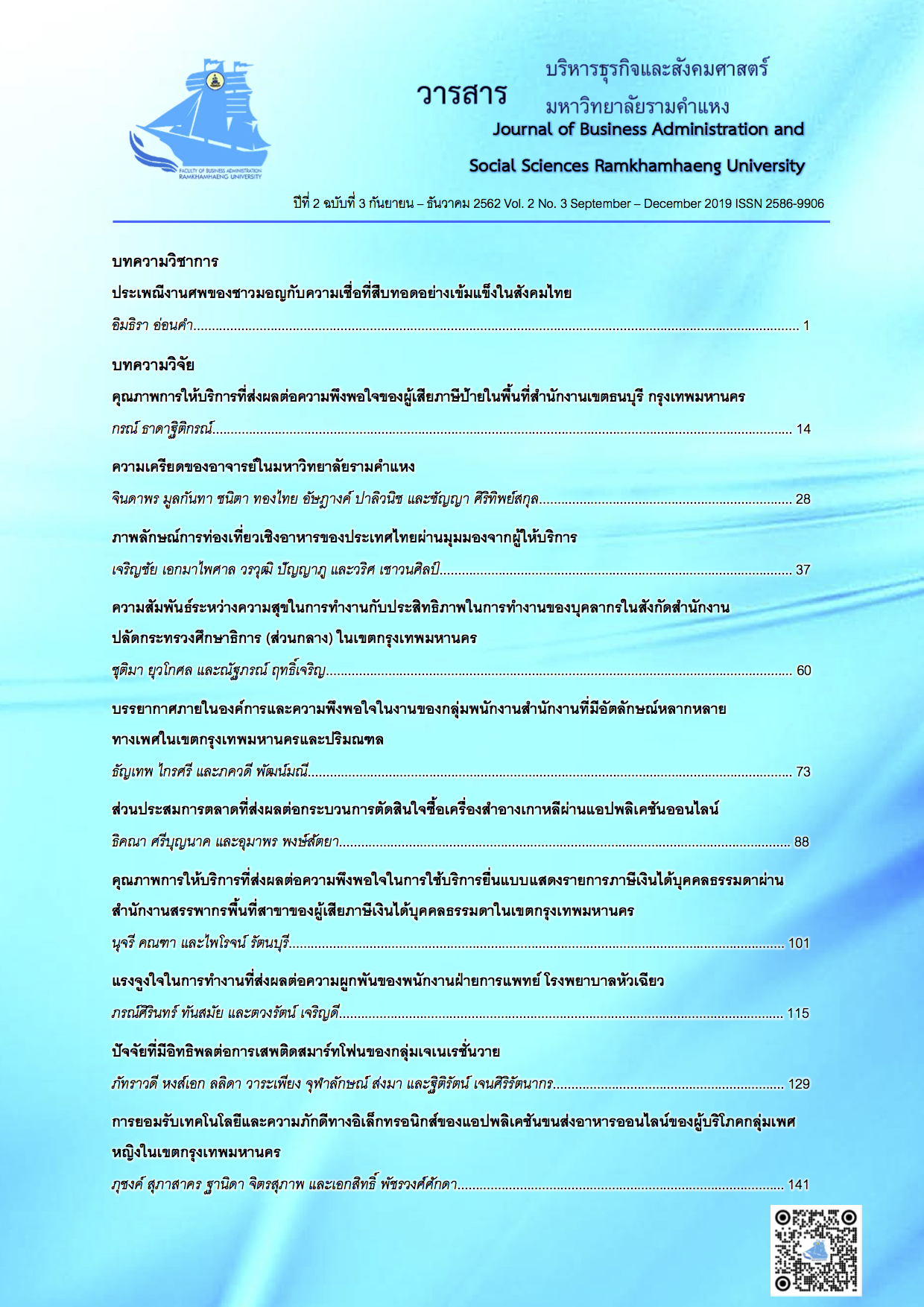The Funeral Tradition of Mon People and the firm succession in Thai Society
Main Article Content
Abstract
In this research investigation, the researchers examine the funeral tradition of Mon people and its firm succession in Thailand. The funeral ceremony of Mon has been inherited from old beliefs. The arrangement of funeral rituals depends on the causes of death. The funeral of those with natural death will be arranged to pay respect to the deceased. Merit making is conducted based on the beliefs similar to Thai tradition with certain different steps such as the making of ghost ladder – ghost door (Bandai Phi – Pratu Phi) and the breaking of the rice pot of the deceased. Unnatural death such as death from accidents or suicide, the body will be kept at the temple for one or two years. Then merit will be made together with the cremation ceremony. Beliefs regarding the funeral tradition which is the identity of Mon consist of the following. 1) Mon Rong Hai (Crying Mon) is a tradition to remember the goodness and to express condolence to the deceased. 2) Yon Pha Ra Fai (a tradition of throwing cloth during the funeral (ceremony) is a tradition to recall the preachings of Lord Buddha which are the spiritual anchors for the dead and the living. 3) Ram Sam That (Dancing to pay respect) is the merit making and remembering the deceased from unnatural death. The funeral tradition succession of Mon is inherited from generation to generation through families, educational institutions, and social institutions. This results in Mon at present adhering to and inheriting this tradition to ensure that it will remain in the future. This is in accordance with the saying that “Mon people lose land but not race”.
Article Details
เนื้อหาและข้อมูลในบทความที่ลงตีพิมพ์ในวารสารบริหารธุรกิจและสังคมศาสตร์ มหาวิทยาลัยรามคำแหง ถือเป็นข้อคิดเห็นและความรับผิดชอบของผู้เขียนบทความโดยตรง ซึ่งกองบรรณาธิการไม่จำเป็นต้องเห็นด้วย หรือร่วมรับผิดชอบใดๆ
บทความ ข้อมูล เนื้อหา รูปภาพ ฯลฯ ที่ได้รับการตีพิมพ์ในวารสารบริหารธุรกิจและสังคมศาสตร์ มหาวิทยาลัยรามคำแหง ถือเป็นลิขสิทธิ์ของวารสารบริหารธุรกิจและสังคมศาสตร์ มหาวิทยาลัยรามคำแหง หากบุคคลหรือหน่วยงานใดต้องการนำบทความทั้งหมดหรือส่วนหนึ่งส่วนใดไปเผยแพร่ต่อ หรือเพื่อกระทำการใดๆ จะต้องได้รับอนุญาตเป็นลายลักษณ์อักษรจากวารสารบริหารธุรกิจและสังคมศาสตร์ มหาวิทยาลัยรามคำแหง ก่อนเท่านั้น
References
กรมส่งเสริมวัฒนธรรม. (2562). การทำศพมอญ จังหวัดนนทบุรี. สืบค้นเมื่อ 28 กันยายน 2562, จาก http://www.culture.go.th/culture_th/pcultureb/nonthaburi/2_1.html
จวน เครือชฌยาจารย์. (2548). ประเพณีมอญที่สำคัญ (พิมพ์ครั้งที่ 2). กรุงเทพฯ: ศูนย์มานุษยวิทยาสิรินธร (องค์การมหาชน).
เฉลิมศักดิ์ บุญมานำ. (2526). มอญร้องไห้. วารสารมนุษยศาสตร์และสังคมศาสตร์ มหาวิทยาลัยขอนแก่น, 2, 35-38.
ชมรมเยาวชนมอญกรุงเทพ. (2551). จดหมายเหตุชาวไทยเชื้อสายมอญ: บำเพ็ญกุศลถวายสมเด็จพระเจ้าพี่นางเธอเจ้าฟ้ากัลยาณิวัฒนา กรมหลวงนราธิวาสราชนครินทร์ ตามลัทธิธรรมเนียมมอญ. กรุงเทพฯ: โรงพิมพ์เดือนตุลา.
บรรเทิง พาพิจิตร. (2549). ประเพณี วัฒนธรรมไทยและคติความเชื่อ. กรุงเทพฯ: โอ เอสพริ้นติ้งเฮ้าส์.
ประชิด สกุณะพัฒน์. (2546). วัฒนธรรมพื้นบ้านและประเพณีไทย. กรุงเทพฯ: สำนักพิมพ์ภูมิปัญญา.
ราชบัณฑิตยสถาน (2546). พจนานุกรมฉบับราชบัณฑิตยสถาน 2542. กรุงเทพฯ: นานมีบุ๊ค.
สุจริตลักษณ์ ดีผดุง, พรทิพย์ อุศุภรัตน์, และประภาศรี ดำสอาด. (2542). สารานุกรมกลุ่มชาติพันธุ์มอญ. นครปฐม: สถาบันวิจัยภาษาและวัฒนธรรมเอเชียอาคเนย์ มหาวิทยาลัยมหิดล.
โสภณ นิไชยโยค. (บรรณาธิการ). (2547). ๘๐ ปีศาสตราจารย์เกียรติคุณ นายแพทย์สุเอ็ด คชเสนี : ๔๘ ปี สมาคมไทยรามัญ. กรุงเทพฯ : บริษัท เท็คโปรโมชั่น แอนด์ แอ็ดเวอร์ไทซซิ่ง จำกัด.
อะระโท โอชิมา. (2536). ชีวิต พิธีกรรม และเอกลักษณ์ทางชาติพันธุ์ของคนมอญในเมืองไทย: กรณีศึกษาในเขตอำเภอบ้านโป่ง จังหวัดราชบุรี. วิทยานิพนธ์สังคมวิทยาและมานุษยวิทยามหาบัณฑิต, มหาวิทยาลัยธรรมศาสตร์.
อิมธิรา อ่อนคำ. (2560). มอญ ตำบลบ้านม่วง อำเภอบ้านโป่ง จังหวัดราชบุรี: วิถีและพลัง. ดุษฎีนิพนธ์ปรัชญาดุษฎีบัณฑิต, มหาวิทยาลัยบูรพา.


